The abandoned city and hundreds of temples and pagodas at Mrauk U (also spelt Mrauk Oo and pronounced ‘Myow Oo’ or ‘Mrow Oo’, depending on Burmese or local Rakhine pronunciation) lie across rolling northern Rakhine State hilltops and form an awe-inspiring sight, whilst providing an experience quite unlike anything else in Myanmar.
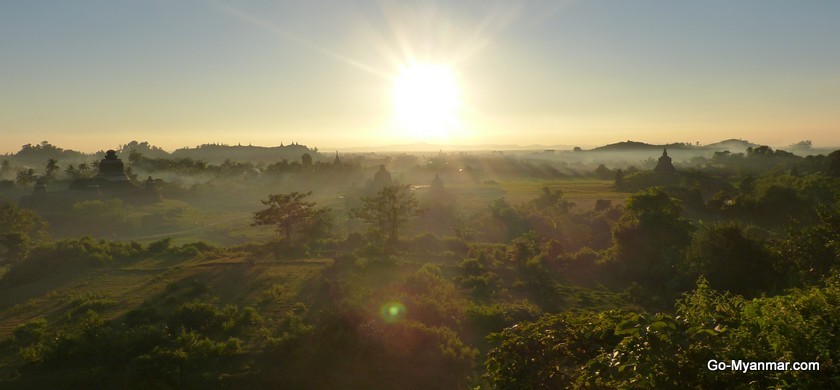
From the 15th to 18th centuries, Mrauk U was the capital of a mighty Arakan kingdom, frequently visited by foreign traders (including Portugese and Dutch), and this is reflected in the grandeur and scope of the structures dotted around its vicinity. But after the First Anglo-Burmese War in 1826, the British moved the regional trading centre down the Kaladan river to Sittwe, and Mrauk U went into decline. Today part of its allure lies in its isolation from the rest of the country; the lack of development; and that (for the moment) you are more likely to bump into a cow or a goat than into another tourist.
We offer a variety of Myanmar country tours that include the sights of Mrauk U. To find out more, go here.
The temples and pagodas
The monuments of Mrauk U are roughly split into northern, eastern, southern and western groups. There are hundreds of temples in Mrauk U, many of which primarily remain day-to-day places of worship for the local Rakhine villagers; what follows is a guide to the most beautiful and historically significant structures. Most temples have name plates in English, with date of construction.
You can see the location of all the temples and pagodas on free maps, which can be picked up at most hotels or at L’Amitié Art Gallery (located in the northern group, just north of the Shittaung Pagoda). Practical information, including how to get around the Mrauk U area, can be found further down this page. Unlike in Bagan, where some of the temples are shut, the interiors of virtually all the temples in Mrauk U are open and ready to be explored.
Check out our YouTube video of Mrauk U's Northern Group and Ratanabon Zedi and, for a wider selection of photos from Mrauk U, go to our Flickr photo set.
The Northern Group
This is the area with the biggest concentration of interesting structures in Mrauk U, as well the area’s best sunset viewpoint; it is also easily walkable from most hotels.
In the northern group you will find Mrauk U’s most famous structure, the Shittaung Pagoda, built in 1535 to celebrate the victory of King Min Bin over the twelve provinces of Bengal. Unfortunately, parts of the brick structure have been encased in concrete, as part of a wider modernisation and ‘Burmanisation’ of some of these traditional Rakhine temples.
However, the interior remains intact, and a labyrinth of stone Buddhas can be found in its outer ring of hallways; the inner ring features represenations of Arakan characters from centuries past, which have kept much of their vivid colour because they have never been exposed to the sun. The main prayer room on the east side of the pagoda features hundreds of Buddhas and elaborate artwork painted on the ceiling. There is a K5000 entry fee for the temples at Mrauk U, but this is in fact only demanded (and sold) at the Shittaung Pagoda.
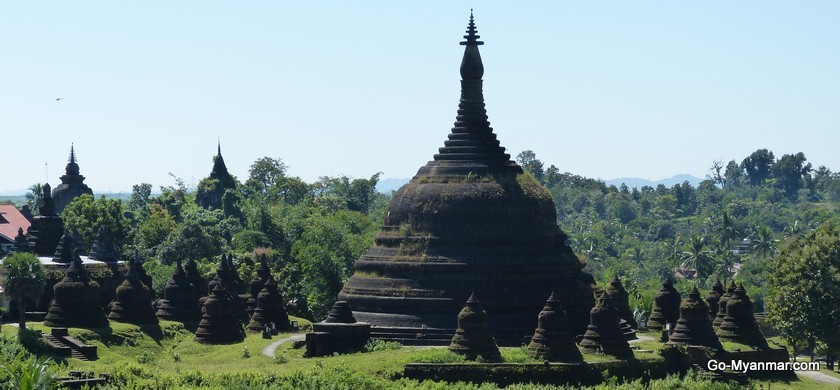
To the immediate northeast of the Shittaung Pagoda are Andaw temple and Ratanabon Zedi. A tooth relic of the Buddha is said to be enshrined at the Andaw temple (constructed in 1598), which features a prayer hall on its eastern side from which you can enter the temple itself. Inside you will find a central Buddha and circular vault with a number of stone Buddhas. The Ratanabon Zedi, built in 1612 by King Min Khamong and his queen, Shin Htwe, is a fine example of the unusual dark, brick-built, bell-shaped style that is common in Mrauk U. And immediatedly to its north can be found a hill which offers the most impressive views in the whole area – most dramatically at sunset.
To the north of Andaw and Ratanabon, you can find a beautiful, secluded rural valley lined with temples. On the eastern side, these include the golden-topped, hillside Ratasanrway and Ratahmankeen temples and the Mahabodhi Shwegu, which has a fascinating interior. These are followed by the Anawma Image (build in honour of Princess Anawzar in 1501), which is situated closer to the valley floor. Further up the valley to the west you will find the Laung Bwann Brauk pagoda (built 1525), although your way may be blocked by oxen bathing in mud! The walls of this pagoda feature remnants of colourful mozaic-like design.
At the end of the valley is the small Pitaka Taik, or ‘library of Buddhist Scriptures’ (built 1591). Not being a temple, this is one of the few structures in the area that you don’t need to take shoes off to enter. The remains of the ancient defences of Mrauk U bring a natural end to the valley walk, but if you fancy exploring further into the rural farmland, the hill is easily surmountable on small paths.
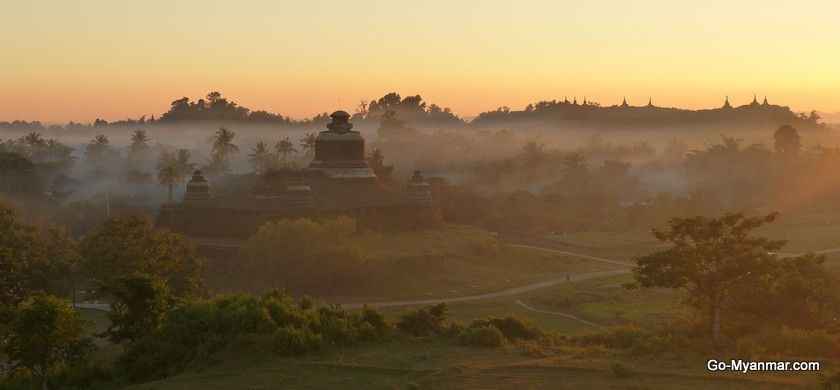
Going back the central complex, opposite the Shittaung pagoda you can find the fortress-like Htukkanthein temple, built in 1571 by King Min Phalaung. It is made striking from the outside by its atypical militaristic design, set as it is on high ground and featuring fortified walls with small windows and only one entrance.
Inside the temple is every bit as unique and fascinating; its dramatic interior chamber spirals clockwise past hundreds of stone figures and Buddhas until you reach the centrepiece Buddha contained in the main dome.
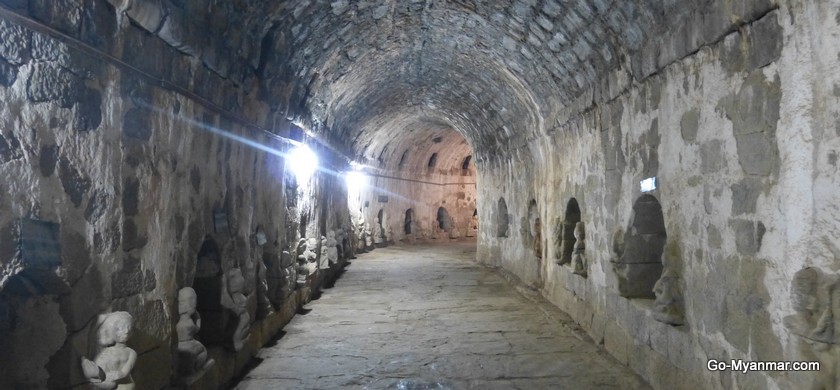
The Eastern and Southern Groups
These groups are more spread out and in general don’t have temples on the same scale as the northern group (with the exception of the grand Kothaung temple), but are nevertheless fascinating and a must on any visit to Mrauk U. The best approach to exploring these temples, whether by car or bicycle, is to take an east to south loop.
Taking the eastern route out from the central palace area, leading out to the Kothaung temple, you will encounter the Mong Khong Shwe pagoda on your right and the Phara Ouk on a hill to your left, facing each other across the road – both worthy of a wander around.
From here you will continue along the road eastwards through a rustic village, after which you will find the hilltop Pizi Phara on your right (south) side. This monument, overgrown with plant life, features a circular enclosure with stone Buddhas facing the four points of the compass and one Buddha at the summit; they are intricately carved with wonderfully serene expressions. This, as well as great views of the surrounding paddy fields and the Kothaung temple immediately to the north, makes it well worth scrambling up the hill.
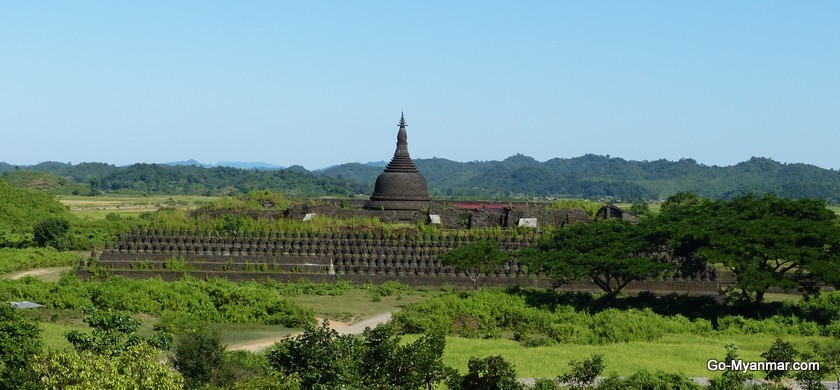
The Kothaung temple is without doubt one of the highlights of Mrauk U; the name refers to the 90,000 Buddha images that it is said to contain. Built by King Mintaikkha in 1553, it served as his attempt to outdo his father King Min Bin’s great effort, the Shittaung Pagoda (80,000 images). Certainly, the sheer number of figures on both the inside and outside (which can be found in varying condition) leave a lasting impression.
After wandering up the steps to enter the temple, you can circle the central stupa twice – once in the atmospheric and vaulted Buddha-lined outer hallway, and then again to witness the sandstone images that surround the stupa out in the open.
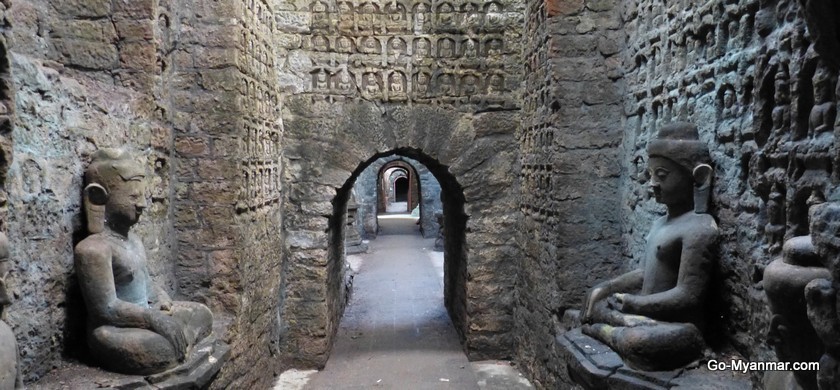
Heading back towards the centre of Mrauk U you can find the Sakya Manaung Pagoda. Built in 1629, it is more ornate than the older pagodas of Mrauk U, featuring golden and bejewelled tops to its structures and two colourful, sword-bearing figures at its entrance.
From here, you can take the road to the southern group. In the south east is the Shwe Taung pagoda, which is one of the highest points in Mrauk U and is popular spot for dawn views. Next along is the hilltop Zinamanaung Pagoda, a beautiful temple that offers panoramic views of the surrounding hills and Lattsaykan lake. There are in fact two pagodas to wander around up here, and to the east (across the valley) you can see a number of pagodas that have been consumed by vegetation, still clearly visible by their distinctive shape – but now the same colour as the trees that surround them.
A few hundred metres further along to the south west is Lattsaykan Gate, which was once one of the main gates into the city; little remains of the outer walls so this section is of particular interest. Immediately on the other side of the gate is is Lattsaykan lake, a picturesque stretch of water that was Mrauk U’s main reservoir.
Heading west, you will find the Bandoola Kyaung, also known as the Sanda Munhni Phara Gri Kyaung Taik (and this is what it says on the name plate at the entrance). This sprawling monastery straddles several hills, and is said to hold a Buddha tooth relic. It is fun just to wander up and down the steps, witness the lives of the monks, and snoop around the artifacts that can be found in the monastery’s various rooms.
There are also a collections of temples and pagodas in the smaller western group, but whether you decide to visit these depends on timing and your energy levels!
The Shittaung Pagoda Festival takes place in Mrauk U in April and features boat races – both real ones in the river and mock ones on land – as well as traditional wrestling competitions. For exact dates and full Myanmar festival listings, go to our festivals calendar.
The town and palace
The Mrauk U site is centred around the crumbling walls of the palace, the interior of which is now empty and the entrances blocked by barbed wire (although it doesn’t take much to breach these defences!). Immediately to the north of the palace, you can find the gold-topped Haridaung Pagoda, which is set on a hill next to a monastery, and provides a clear view of the palace site – as well as views over the temples and plains to the west.
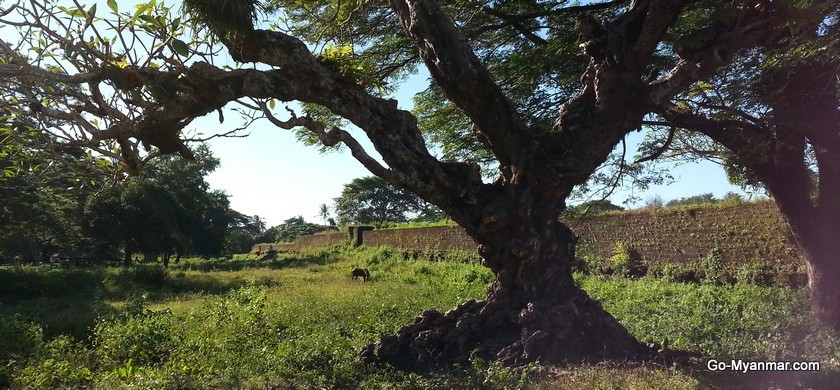
The various hotels and guesthouses of Mrauk U surround the palace, and the main street and market of the current town lie immediately to its west.
The river jetty, which is the arrival point for most foreign visitors, is located to the south west of town (click here for more details on how to get to Mrauk U). You will most likely be offered a trishaw (cyle rickshaw) on your arrival, which should cost no more than K1000 per person to most hotels.
If you are looking for places to eat, for the most part Mrauk U offers simple teahouses and beer stations, most of which are in the area surrounding the palace. Happy Garden Restaurant is one of the most pleasant, with its leafy garden and well prepared mixture of Rakhine and Burmese food; it can be found opposite Tha Kan Hla Lake just to the west of the palace, next to Golden Star guest house. The number one spot for foreigners is Moe Cherry restaurant; it is slightly more expensive than the other options, but generous portions of tasty local dishes are served out by the friendly owner, who is also the chef. It is located on the main road to the east side of the palace.
Getting around and practical info
The best way to get around Mrauk U is either to hire a bicycle for the duration of your stay (as always being mindful of the heat), or hire a Jeep for the first day to explore the eastern and southern groups of temples, and then discover the northern group on the second day by foot. A Jeep (usually open top but with a cover for sun protection) will cost around K25,000 per day; that will likely come with a non-English speaking driver who should nevertheless be able to tell you temple names. An English-speaking guide will cost significantly more.
It is safe for foreigners to visit both Mrauk U and Sittwe and there are no travel restrictions in the area.
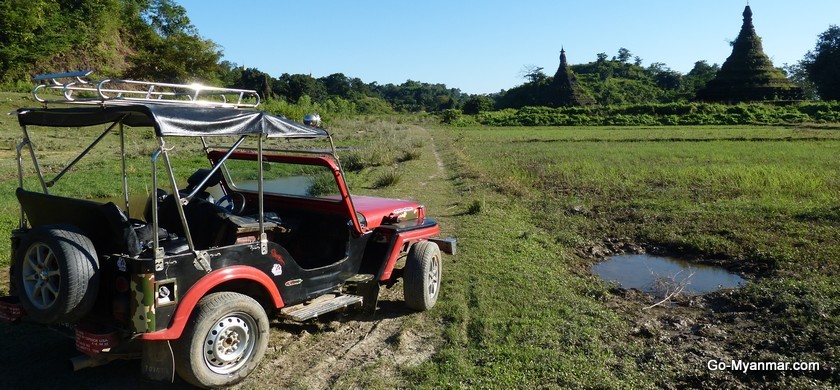
Two days is sufficient to explore Mrauk U itself; if you wish to travel further north to the other archaeological sites in the region and explore ethnic Chin villages upriver, you will need more time (see further down this page for more detail).
There are frequent electricity black-outs in Mrauk U (although most hotels have back-up generators), and wifi is difficult to find. However, this simple existence and lack of contact with the outside world is part of Mrauk U’s appeal; the lack of artificial light makes the views even clearer and more beautiful, an effect which is further enhanced by the smoke that drifts across the valley floors at sunrise and sunset. And the frequently candle-lit atmosphere in village streets is made even more enchanting by the lack of cars.
To make an inquiry or plan a Mrauk U adventure, fill out this form
Chin villages and further afield
Wethali (Vesali), a small village that was the capital of an ancient kingdom over one thousand years ago, lies 10km north of Mrauk U. You will find the relatively well preserved layout of its old palace here and, further down the road, the Great Image of Hsu Taung Pre – a large sitting Buddha built in the local style. The journey from Mrauk U takes two hour by car, or whole day bicycle round trip.
The Mahamuni Paya once housed the famed Mahamuni Buddha, but it has since been moved to Mandalay. However, there remain a number of interesting shrines and images in the area, as well as a museum. The Mahamuni Paya is located 40km north of Mrauk U, and a jeep will cost around K35,000 for a day outing, which will include Wethali and the Great Image of Hsu Taung Pre. The road is very rough and slow.
Another alternative for a day trip from Mrauk U is to visit some Chin ethnic minority villages. The journey upriver becomes very scenic as the valley narrows, and the visit itself will give you the opportunity to observe local traditions first hand and meet Chin villager women, known for their distinctive tattooed faces. A boat will cost around K40,000 for the day.
Please note, Mrauk U is currently off limits - travel is not permitted for foreigners and tours are not possible; we will update this website as soon as the situation changes.







